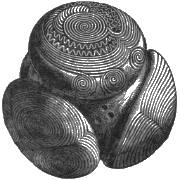Canmore Site 64780: WHITE ISLE - DUNSCORE - EARTHWORK (PERIOD UNASSIGNED), STRUCTURE(S) (PERIOD UNASSIGNED), QUERN
Description
| Site Name | WHITE ISLE |
|---|---|
| Other Name(s) | n/a |
| Site Number | NX78SE 1 |
| Broad Class | AGRICULTURE AND SUBSISTENCE (OBJECT), UNASSIGNED, TOOLS AND EQUIPMENT, MONUMENT (BY FORM) |
| Site Type(s) | EARTHWORK (PERIOD UNASSIGNED), STRUCTURE(S) (PERIOD UNASSIGNED), QUERN |
| NGR | NX 7586 8419 |
| NGR accuracy | NGR given to the nearest 10m |
| Local Authority | DUMFRIES AND GALLOWAY |
| Parish | DUNSCORE |
| Record created | 1988-07-04 |
| Last updated | 2000-04-12 |
Archaeology Notes
NX78SE 1 7586 8419.
(NX 7586 8419) The neck of the peninsula named White Isle is crossed by a well-defined rampart and ditch some 500 ft long. At the W end, where best preserved, the rampart is 11-12 ft above the ditch and 4 ft high at the rear. There is a gap, 80-90 ft wide, in the centre of the earthwork. Two sections were cut by Corrie who showed that the rampart, of clay and rough gravel, stood 6 ft 6 ins above the natural ground level, while the ditch was silted up to a depth of 5 ft 10 ins. A rough stone pavement, 10 ft wide, was found running in the rear of the rampart; it is traceable as a change in vegetation.
Part of an upper quern stone found on the peninsula in 1971 is in Dumfries Museum (Acc No: 1971/37).
J Corrie 1906; RCAHMS 1920, visited 1912; A E Truckell 1972; Dumfries Museum 1972
The univallate earthwork, generally as described, encloses 3.0 hectares of undulating grassland. The 15.0m wide ditch is up to 1.5m deep at its NW end but elsewhere it is heavily silted and it is now only a vague depression at the south end. There is no trace of causeway.
The earthen rampart is substantial at its W end being 3.0m high externally and 1.0m high internally. The central gap is now too wide for an entrance but it may have been exaggerated by later use. The rampart continues along the SE edge of the peninsula; it has been mutilated so that there is now little trace of an internal scarp. There is no evidence of the stone pavement and no significant change in vegetation was noted.
The remains of a rectangular building, which almost certainly post-date the rampart, lie on the north side of the island. The turf covered footings are 10.0m by 5.0m and there is a spread of cleared stones nearby.
The age of this defensive work is obscure but it is probably prehistoric, perhaps an IA settlement on the shore of Loch Urr. The name White Isle was not confirmed.
Surveyed at 1:10 000.
Visited by OS (BS) 21 February 1978
A survey of the White Isle earthwork incorporated two rectangular structures and other features lying on the tip of the promontory. Sponsor: Historic Scotland
CFA 1991.
Identifiers and Links to Other Records
This record has no links! Would you like to help?
| Identifier / External Link | Linked Record | Status | Comment |
|---|---|---|---|
| Canmore Site Number (legacy): NX78SE 1 | No linked record |
This area is visible only to logged in users.
